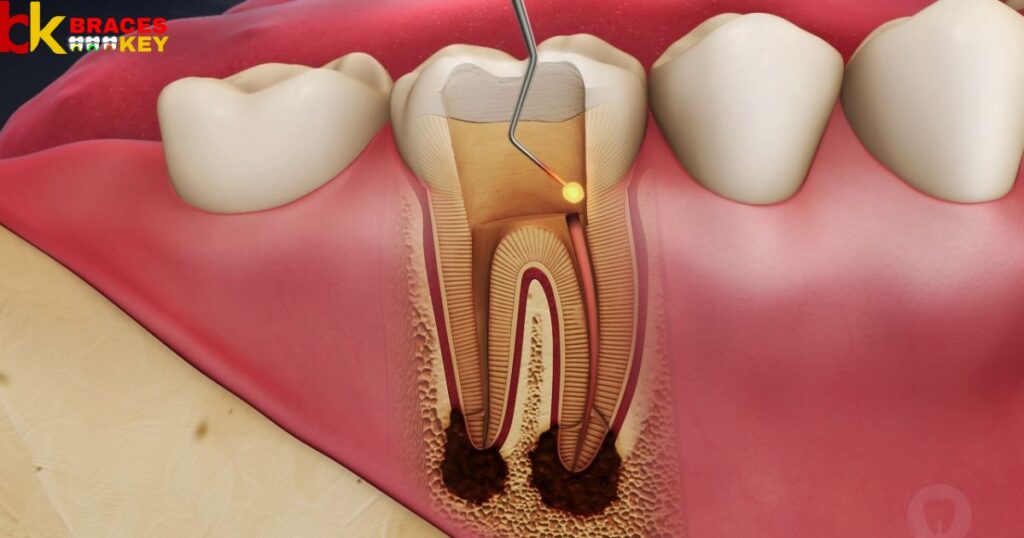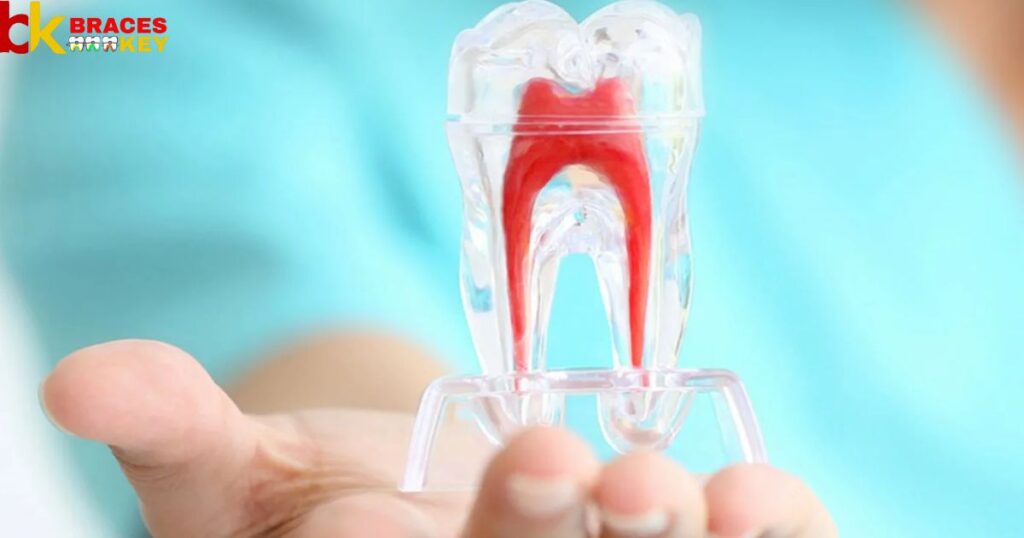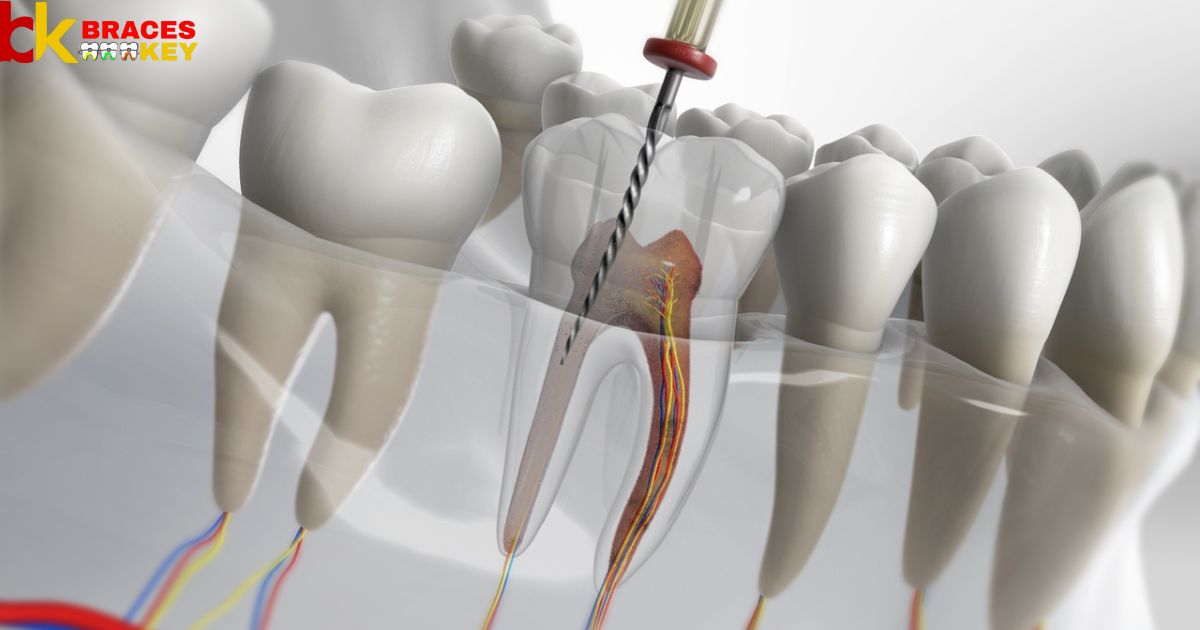A root canal is a dental procedure performed to repair and save a tooth that is severely damaged or infected. Inside each tooth is a soft inner area called the pulp which contains nerves, blood vessels, and tissue. During a root canal, the infected pulp is removed.
Signs that a root canal may be needed include severe tooth pain, sensitivity to hot or cold temperatures, pain when chewing, or a tooth that is darkening in color. The damage is often caused by deep decay, cracks, or repeated dental procedures on the tooth over time. Without treatment, the infection can spread.
The procedure involves numbing the tooth and gum with local anesthesia first. Then a small hole is drilled through the chewing surface to access the pulp chamber. The pulp is cleared out using tiny precision instruments and the inside of the tooth is cleaned and shaped. The empty space is sealed with a rubber-like filling called gutta percha.
Key Takeaways
- A root canal is performed to save a tooth that is infected or damaged inside the pulp. Left untreated, this could lead to tooth loss.
- The procedure involves drilling a small access hole, then carefully cleaning and shaping the inner tooth chambers and root canals with specialized instruments.
- Filling the inside of the tooth with gutta percha helps seal it tightly and prevents reinfection that could spread to the jawbone. Don’t miss to read out this topic Dental Insurance.
- Most people feel little or no pain during a root canal because the tooth area is completely numb from local anesthesia administered beforehand.
- While root canals may seem daunting, modern techniques and materials have made the procedure highly successful. With a root canal, patients can often keep their natural tooth for many more years rather than losing it to extraction.
Overview Of Root Canal

A root canal procedure treats an infected or damaged tooth pulp by removing it and filling the hollow inner chambers. The dentist carefully drills into the tooth, cleans out all damaged material with tiny tools, then seals the empty canals to prevent further infection.
It aims to save natural teeth in distress through disinfection and internal sealing. Most feel little pain due to freezing, and a temporary filling later becomes permanent to fully enclose the inner healing. With a root canal, precious teeth have a new lease on life.
Step By Step Guide To Root Canal
- The tooth and surrounding gum area are numbed using local anesthetic injections. This ensures the patient feels no pain during the intricate internal work.
- A small opening is drilled and surgical tools are precisely guided into the long root canals. Infected pulp tissue and bacteria are cleaned out in delicate motions to fully disinfect deep inside the tooth.
- The now-empty root canal spaces are smoothly shaped and dried. Tiny gutta-percha fiber cones are placed with sealant to completely fill the inner voids, preventing future recontamination of this surgically-treated tooth area below the gumline.
Teeth Whitening
Bright smiles boost confidence and first impressions. At-home bleaching trays with tailored gels deliver DIY results, empowering everyday routines with a simple process. Dentist-supervised treatments harness concentrated peroxides for faster, professional whitening under careful monitoring.
Tailored to individual needs, sensitivity is minimized through personalized fitting. Gentle whitening preserves healthy enamel better than abrasives, for lasting brightness inside and out. Tailored to individual needs, sensitivity is minimized through personalized fitting.
What Is A Root Canal

When pulp deep inside enamel walls succumbs to injury or caries, root canals intervene to preserve teeth from premature extraction. Within protected roots run blood vessels and nerves that sustain dentin and provide sensation; but trauma leaves these channels vulnerable to contamination.
Through delicate procedures, endodontists clean, shape and seal damaged root spaces. Filling and capping revived teeth shelters their livelihood, restoring sturdiness where decay once imperiled foundation and function. Refuge from extraction is thus derived via root canal therapy.
Root Canal Procedure
Within the tooth’s interior tunnels run its lifeblood vessels, now compromised. Through microscopy the endodontist navigates these winding roads, delicately drilling access points and threading nano instruments to chip away infected pulpal remnants.
Antiseptic irrigants cleanse and shape the purified paths, eliminating reservoirs for inflammation. Temporary dressings allow monitoring of sterilization’s success. With no sensation returned, the evacuated root space receives adhesive seals and material fills, fortifying the compromised foundation from further deterioration or symptomatic flare-ups.
Root Canal Cost
Root canal treatments replenish teeth compromised from within, saving natural structures from extraction. Through delicate, specialized procedures endodontists rescue foundations in danger. HSuch specialized surgeries require precision tools and materials, extensive training to master microscopic navigation of endangered roots.
Multiple visits and permanent restoration further elevate expenses, though totals pale compared to alternatives like dentures or implants. For livable costs patients gain lifelong anchors, sparing expense and hassle of replacement.
How Long Does A Root Canal Take?

Root canal procedures involve meticulous cleaning and shaping of the intricate root canal system to remove diseased tissue. While every case differs in complexity, most root canals require at least two visits to complete treatment properly.
At the initial visit, X-rays are taken and the tooth anesthetized before cleaning begins; follow-ups allow for thorough disinfection and monitoring of healing. Though delicate work, endodontists finish most root canals quickly – within the time of typical dental visits. With patients’ cooperation, compromised teeth receive new life in brief scheduled sessions.
How Much Is A Root Canal?
While prices vary by dentist and tooth, a root canal aims to fall between the cost of simple repair and full replacement. Front teeth requiring intricate work drive the higher end, whereas molars pose less complex root systems. Multiple factors also change the bottom line, from insurance provisions to difficulty of the case.
Saving a natural foundation proves more affordable in the long run than bridgework or implants. Payment plans help such specialized restoration fit most budgets. In the end, the expense preserves wholesome oral health for decades to come.
Do Root Canals Hurt?
Treating infected or dying pulp once caused significant pain, as no anesthetics reliably blocked transmission to the brain. Yet modern innovations allow root canal therapy with minimal discomfort. Precise injections now numb specific nerves, eliminating sensation within endangered teeth.
Microscopic tools gently clean internal passages inaccessible to sharp drills. And lasers may soon further minimize pressure or heat that sometimes causes stiffness or soreness. With the care routine for most root canals today, recovery feels like a simple filling instead of past ordeals.
What Happens During Root Canals?
Inside tooth roots run delicate blood vessels and nerve fibers supplying sustenance; but exposure leaves these channels vulnerable to decay-causing bacteria. Through specialized procedures, root canal therapists disinfect and reshape vulnerable tunnels, rescuing compromised foundations.
Small instruments delicately scrape ravaged walls, suctioning debris while antimicrobial washes sterilize. Medications later seal emptied pathways from future invasion, fortifying weakened structures. The preserved roots integrate for long-term service, sparing extraction’s disruptions through endodontic conservation.
What Happens After A Root Canal?

Following root canal therapy, the tooth feels relieved of pressure and pain as inflammation subsides. Temporary fillings allow monitoring of healing over days. If tenderness fails to return, the sterile hollow root receives permanent adhesive and reconstructive materials.
A crown often caps the exposed dentin for protection against fracture. Within weeks, the natural structure assimilates to its new pulpless reality, strengthened from within like a refurbished foundation of a house. With treatment complete, a restored tooth functions for many more years.
What Are The Potential Benefits Of Root Canals?
Root canals save teeth from extraction, preserving natural structures rather than necessitating implants or dentures. Successful therapy maintains facial structure, chewing ability, and a balanced bite while disinfecting otherwise infected roots.
Without treatment, unchecked contamination could spread through the body, so endodontics thwart wider health risks too. And they enable restorative procedures to restore full strength and function for decades more. With costs comparably lower than alternative treatments, root canals offer substantial physical and financial benefits.
What Are The Risks Or Complications Of Root Canals?
While endodontic therapy effectively cures most infected teeth, unpredictable factors can thwart complete healing in rare cases. Complex root morphologies pose intricacies that make thorough cleaning challenging, and new infections may occasionally recur post-treatment from missed bacteria.
Instruments may also file through roots, potentially weakening remaining structures. Yet modern microscopes and improved techniques minimize such complications. With timely follow-ups and protective crowns when indicated, root canal-treated foundations endure long-term nearly as well as fully vital alternatives.
How Long Does It Take To Recover From A Root Canal?

Immediate pain relief signals successful anesthetizing, yet microscopic work causes lingering stiffness similar to ordinary fillings. Within days, residual ache subsides with anti-inflammatory drugs and relaxed chewing on other teeth. A week lets swelling retreat and tender dentin toughen under temporary fillings.
Permanent cementation may induce minor recurrent tenderness, but crowns applied within months shield sensitive roots, letting nature incorporate non-vital spaces. Full function and imperceptible results usually emerge within three months for smooth lifelong service.
How Do I Take Care Of Myself After A Root Canal?
Gentle habits protect recently treated teeth. Soft foods spare pressure as pulpless roots adapt. Ibuprofen curbs minor pain through healing. And temporary fillings guard exposed dentin until ready for crown placement within weeks.
Flossing beneath temporary material keeps the new seal pristine. Follow-ups ensure no lingering infection develops as sterilized roots are incorporated medically. With care, the conserved foundation assimilates to survive as if untouched for many future years of trustworthy service.
What Are The Signs Of Needing A Root Canal?
Teeth were not designed to last forever, though proper care extends their lives. When nerve damage takes hold, deep pain from biting or sipping hints at infected pulp in need of attention. Swelling gums resemble approaching abscesses internal decay unleashes.
Nocturnal throbbing follows daytime discomfort ignored. Yet before such telltale signs emerge, early endodontic intervention preserves sensitive interiors sure to further decompose without skilled therapy. Timely treatment saves teeth otherwise destined to fracture or fall.
How Does Endodontic Treatment Save The Tooth?

Root canals retire ravaged pulp, rescuing foundations by disinfecting contaminated tunnels. Under a microscope, tiny tools gently scrape troubled walls and rinse putrid contents from harmed channels invisible to the naked eye. Sealing entry and exit portals fortifies previously vulnerable roots.
The conserved structures integrate reinforced scaffolding beneath durable facades like strong columns beneath sturdy architectural shells. As extraction severs stable anchors, endodontics conserves natural infrastructure for long-term usefulness otherwise denied.
Will I Feel Pain During Or After The Root Canal?
Though pressure sends pulp into spasm, numbing agents let root canal therapy proceed painlessly. Many feel nothing but subtle pressure caused by delicate micro-instruments. Swelling may bring mild discomfort post-treatment as inflammation resolves, but over-the-counter medications provide relief.
Tiny cracks sealed and cleared, most report quicker recovery than fillings alone. Within days, lingering ache fades as the emptied tooth assimilates its changed internal conditions. Properly performed, endodontics cures infection practically pain-free.
Root Canal Treatment Steps
Infected pulp must be removed to purge contamination from twisted roots. First, anesthesia blocks nerve sensation as tiny drills carefully expose irritated fibers. Complex tunnels are then scrupulously scrubbed and sterilized using specialized tools and washes.
Pressure allows thorough rinsing of inflamed spaces invisible to the naked eye. Once cleansed, medicated filling solidifies impervious entrances, sealing off future invasion. Protective crowns shield renovated foundations from threatening cracks or breaks. Thus refurbished from within, teeth resume durable service.
Cleaning And Filling The Root Canal

Inside tooth roots winds a delicate pulp, prone to decay from deep infection. During treatment, specialized instruments precisely scrape and rinse ravaged walls, meticulously removing contaminated material. Tiny drills and needles disinfect branching tunnels where bacteria spread unseen.
Antiseptic washes then flush putrid contents from impossible recesses, sterilizing remnants invisible to the human eye. Lastly, biocompatible filler solidifies impregnable barriers, cocooning once-vulnerable interiors from future harm. Effectively sealed, the inner sanctum now stands fortified.
Sealing And Fixing The Tooth
The emptied tooth awaits final fortification. Biocompatible sealer encapsulates winding conduits late home to ravaged fibers. Then, impervious restoration shields exposed dentin from future fracture. Whether porcelain mimicking nature or sturdier materials, the custom-crafted facade fuses tooth and technology.
Encased in protective armor, the overhauled foundation reinforces the jawbone beneath. Reborn from within, it serves renewed, able to withstand time’s grinding down without decay dictating its doom. Evolved but enduring, the preserved teeth fulfill function long into the future.
Adding A Crown
Root canal therapy transforms an infected tooth, but exposed radicular dentin remains fragile below enamel’s former curve. A crown precisely contoured to contours thus reinforces vulnerable structure, just as a helmet strengthens what lies within its bounds. Whether porcelain mimicking
Nature’s design or gold fortifying with richness, the facsimile facade bonds chemistry and craft, fusing tooth and restoration as one indissoluble whole. Rebuilt from within and shielded without, the conserved foundation reclaims force and endurance for lifetimes of service yet to come.
Root Canal Recovery Time
Immediate relief follows anesthetized work, though lingering stiffness may mimic familiar fillings. Just days suffice for residual discomfort to fade, as anti-inflammatories ease tender roots into renewed rest.
A week allows swelling’s retreat and punctured dentin’s renewing beneath temporaries. A few more yield to permanent cementing, though minor recurrence signals natural healing. Full recovery takes but short months, with white reflections and sturdy function beyond the reach of aching’s memory alone under comfortable, imperceptible crowns.
Are Root Canals Necessary?

When a tooth suffers from deep decay or infection, the painful option is to remove it. But root canals offer an alternative – they save the tooth from extraction. Through the canals dentists clean and shape, disinfecting what lies below.
It appears drastic but prevents what’s worse, losing a tooth completely is no minor curse. A root canal permits function where otherwise there’d be an empty space, keeping natural teeth intact should always be the case.
What Is The Root Canal Procedure Like?
The root canal procedure aims to save teeth from infection and pain. First the dentist numbs the tooth being treated to alleviate any discomfort. Small tools gently clean and shape each root canal, removing infected pulp bit by tiny bit.
Lasers or drills are used to carefully debride and sterilize the inner anatomy. Medicated materials may then be placed in canals as they’re tightly sealed. Though not fun, it’s better than extraction – with rct your tooth gets to stay intact and functional once again.
FAQ’s
How Painful Is A Root Canal?
Anesthesia renders intricate work painless, temporary discomfort seldom outweighs longevity gained.
What Exactly Happens In A Root Canal?
Infected pulp evacuation, antiseptic cleansing of inner tunnels, and impervious sealing restore compromised foundations from within.
How Long Does A Root Canal Usually Last?
When infection’s threat subsides within intricate channels, restored foundations brace against hard use through lifetimes, their durability an artful restoration’s tribute.
How Do I Know If I Need A Root Canal?
Recurrent episodes arouse suspicion; throbbing unrelieved by ordinary analgesics affirms subterranean inflammation demanding specialized care.
Conclusion
Through minute access portals, specialized instruments sterilize contaminated passageways and solidly encapsulate conserved foundations. Precision techniques extract unrest below resistant surfaces, arresting deterioration through well-timed intervention, Root Canal.
Preserved anchors endure where extractions sever, strengthening dental infrastructure and delivering invaluable functioning restored from within vulnerable territories. Root canal therapy salvages essential units through conservation, forestalling further damage and functional loss.








